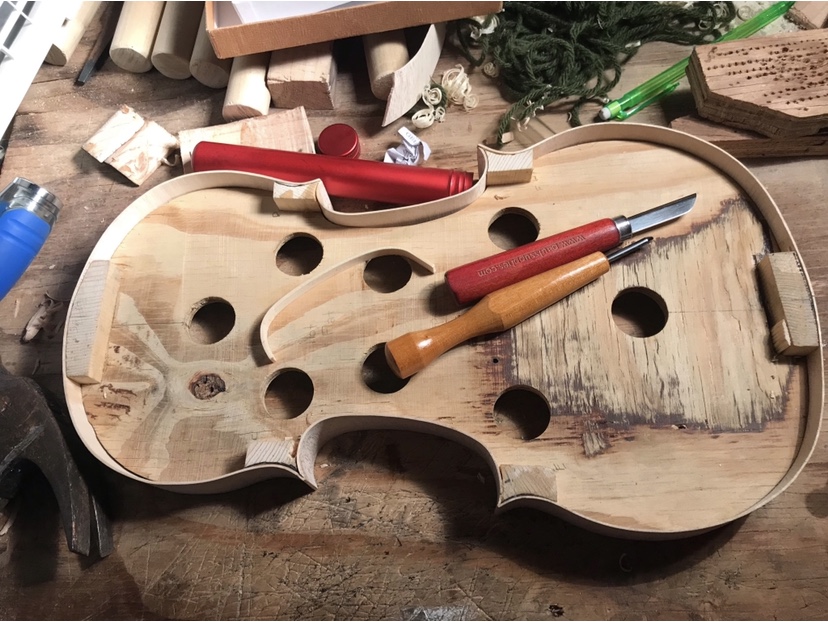In making a violin, junior double fine arts major strings together his love for art and music
Precision, planning, patience proved instrumental in helping Mason Shackelford realize a labor of love一crafting a functioning instrument一he first envisioned in sixth grade
MAKING THE CUT: Shackelford’s carving tools and violin base lay on his desk at the start of what would become a year-long crafting process. From the early preparation stages to the final coat of varnish, the process was one of time and dedication. “It was one of things where time just disappears,” he said.
November 4, 2020
After working on it for a summer, junior Mason Shackelford could feel the end of his project getting close. Just a few more weeks, he thought to himself, until his hand-crafted, working violin would be complete.
A few more weeks passed. Then months. Then a year.
“It was one of things where time just disappears,” he said. “If I had realized I was a whole year and hours and hours away, I don’t think I would have finished it,” he added with a laugh.
The idea started when Shackelford was in sixth grade. Simply put, he just wanted to play more violin music.
“Some of my friends were like ‘Oh, you can just borrow my violin’, but then, at that point, it was more that I actually wanted to make something,” he said. “For art class, I made a cardboard viola, and ever since then I kind of wanted to combine my love for art and love for music and make something to play on.”
As a double-major at McCallum in music and visual arts, Shackelford is used to working with his hands. Making an instrument from scratch, however, didn’t prove to be simple.
“I found a website that had so much information — it would take a few days to read through all of it,” Shackelford said. “It had the sides, the front and the back, and then each of those had ten different steps, and each step had a few pages of instructions.”
According to Shackelford, the process begins with a base mold. Wood is cut and carved to form the exterior, with each movement of the knife allowing the right frequency of sound to resonate in the material.
“That’s what makes the difference between a really good violin and a really cheap one,” he said.
Shackelford performs “Ave Maria” by Franz Schubert on his polished product. Video courtesy of Mason Shackelford.
Next up is carving the neck and scroll.
“At the time I thought, great, those are the hard parts, but then you have it to put it all together,” he said. “And that takes a whole bunch of angles and precision.”
The pieces are carefully placed together, and the instrument starts to take shape. Strings are put in place, and the ending seems to be just around the corner. But with each step closer to the finish line, the race seems to come to a ritardando.
“That’s kind of the frustrating part,” Shackelford said. “I finished all the carving, and then I strung it up to make sure it played, but then I had to set it down for about a month, to varnish it. And that took a long time.”
Many summer nights and a coat of varnish later, the instrument was complete.
“It was weird when it was finally finished,” he said. “It was very satisfying, but it was also something I had, towards the end, been looking at every single day, working on for about six hours, so it was very normal to just be looking at. So I don’t even think it seems like something I made; it feels like somebody else made it.”
As for making music with his own work, Shackelford can only describe the feeling as just really cool.
“My family thought it was cool, too, but often I get the feeling that people don’t believe it,” he said. “If you look it up online, there is basically a pre-made violin with most of the parts already made, so I think a lot of people think ‘Oh, he just got that and worked a month on it’. But then I have to show them that I actually started with, you know, blocks of wood, and I went from there.”
And although his brother teases him that a homemade cello is somewhere in his future, Shackelford feels that a break from carving and crafting is much-needed.
“In the beginning, I really did think I would do it multiple times,” he said. “I thought, ‘I’ll do it once, and then next time it’ll take half the amount of time or a quarter the amount of time!’ But as I was doing it, I realized that it was only gonna shave off maybe 50 hours. Most of the process is very unique to the violin, and you can’t rush through it. Every single little part counts.”
“I have a lot of respect for violin-makers,” he added with a laugh.





Jack Strub • Nov 15, 2020 at 7:28 pm
I loved this article! It was incredibly well written and easily drew me in. I think it is very cool and impressive how he made his own violin, and inspires me to be creative!
Ingrid Smith • Nov 5, 2020 at 10:11 pm
Wow, this is so impressive! I play the violin, so I know just how complicated the instrument is and it’s so cool that he made one himself! I wouldn’t even know where to start when making a violin or have the patience to keep going. The finished product is really good too. I’m amazed!
Ari Miller-Fortman • Nov 5, 2020 at 9:01 pm
As a violinist and someone who’s studied the makings of older and newer violins — this is an incredible accomplishment! I’m super excited about how well it turned out, and his wonderful general technique and playing only added onto that. The violin itself has a wonderful tone for being completely homemade, and the resonance is up to par to violins made by specialists. It’s insane how he took into account how precise each measurement and carving needs to be. He really could take up a career in this! I’m super impressed. The picture on top of this report is a wonderful photo: it shows the unusual view of a the inside of a violin before the end product with varnish and finish; even a finished violin looks different on the inside than the inside of a violin when first starting to carve it. I think it’s super great how he included a video of him playing it too! That really gives a lot of insight into how it sounds, which matters the most in the world of violin-making.
Julian Magee • Nov 5, 2020 at 7:18 pm
Pretty incredible what Shackelford did here. I know I wouldn’t have enough creativity or motivation to do something this cool. Creating your own instrument from scratch is really impressive!
sophi beardslee • Nov 5, 2020 at 1:23 pm
this was an incredible article! Its so fascinating and impressive that he made this beautiful violen on his own. Nice job!
Fatima • Nov 4, 2020 at 8:01 pm
This is an amazing article! The violin is amazing and impressive. I really liked the article!
Caroline Owen • Nov 4, 2020 at 6:58 pm
If I saw a photo of the violin without context, I would probably just think it was a violin made by a huge company, not homemade! It looks very professional. I also liked how the article detailed the steps of the project, not just the final product.
Lily • Nov 4, 2020 at 4:17 pm
Very cool article! The violin is very impressive and this article is wonderfully written, good job!